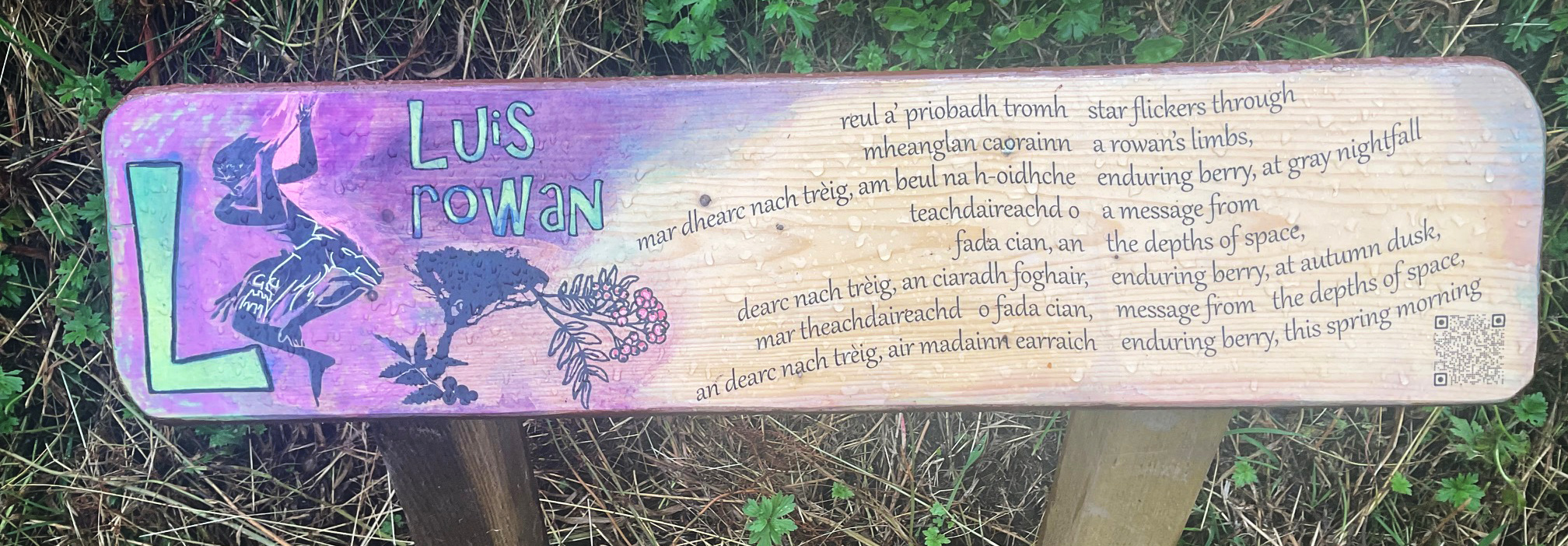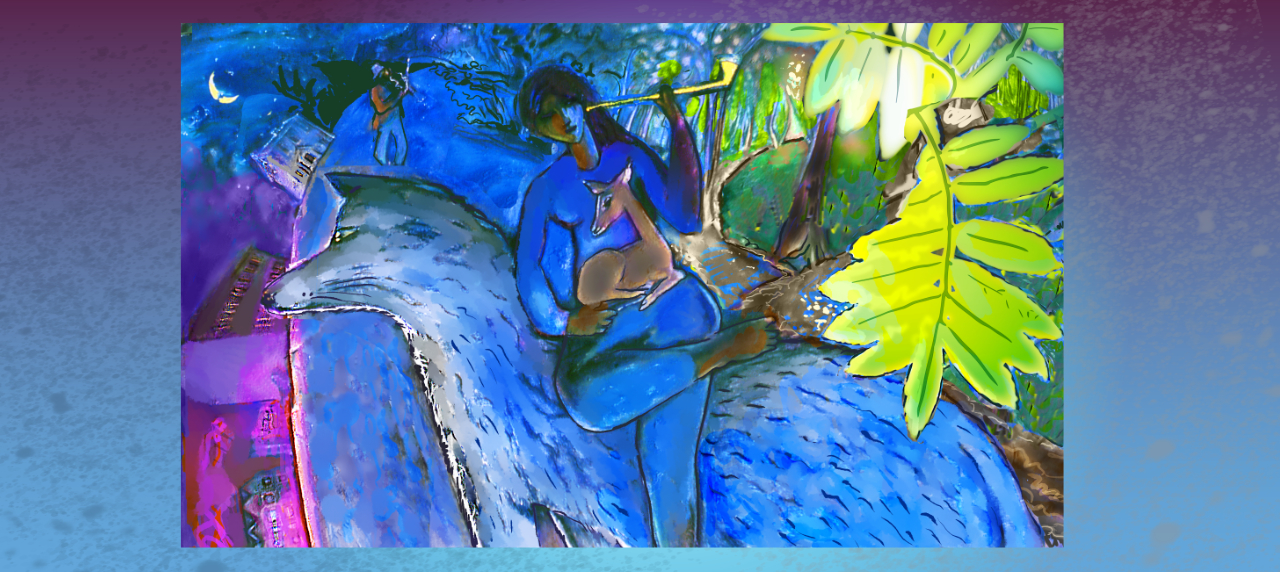
B L N F S H D T C M G P R A O U E I


reul a’ priobadh tromh
mheanglan caorainn
mar dhearc nach trèig,
am beul na h-oidhche
teachdaireachd o
fada cian, an
dearc nach trèig,
an ciaradh foghair,
mar theachdaireachd
o fada cian,
an dearc nach trèig,
air madainn earraich
star flickers through
a rowan’s limbs,
enduring berry
at gray nightfall
a message from
the depths of space,
enduring berry
at autumn dusk,
message from
the depths of space,
enduring berry
this spring morning


Like the hawthorn, rowan is one of the rose family. A frost-resistant tree, rowan can live on hillsides up to 6,000 feet (in the Alps). It is not a tall tree and lets many other plants grow around it, needing little from the soil, The large amount of light coming through its canopy allows for its famed wealth of berries and these feed many birds.
Rowan has clusters of creamy white five petalled flowers, that develop into berries. The berries change from green to orange and then to the brilliant scarlet of autumn. In dark spruce plantations, rowan can be very helpful in breaking up the soil and changing slowly decomposing needles into fertile humus.

Rowan berries are not poisonous, but contain parasorbic acid, which can upset the stomach if eaten raw. They also contain sugar, carotin, pectin, essential oil, vitamin A and more vitamin C than oranges and lemons. The dried berries and leaves strengthen the immune system, cleanse the blood, help diarrhoea and the kidneys, and prevent coughs.

Rowan is also called mountain ash, or quicken tree (sorbus aucuparia) quickbeam. Its wood is used for tool handles, cart wheels, planks and beams, walking sticks, boats and in the construction of iron age roundhouses, while the bark is good for tanning and dyeing.


Its berries are used in ales, liquers, cordials, jam and jelly and even a coffee substitute, while the forked branches can sometimes be used for metal divining. Medically it is a laxative to treat urinary tract infections, or be gargled for sore throat, laryngitis, tonsils, and (in the Navy years ago) even formed a cure for scurvy.

Understood as a 'magical' tree, rowan has a tradition that
"does
not allow the use of the tree's timber, bark, leaves or flowers, nor the cutting of these,
except for sacred purposes under special conditions" (Fife 1994).
As protection against spells or anything evil, rowan is legendary. It appears to be able to grow where no soil exists, such as in the forks of other trees or on bare rock. In fact, growing on another tree reinforced its qualities as belonging to both earth and heaven, like mistletoe. Used for divination and to invoke spiritual beings, rowan trees were commonly planted at sacred sites and stone circles. An inspirational tree, rowan has the old Icelandic name of runa (secret or whisper), in common with the runes, for which it was used. An old custom throughout Europe was the annual use of the Life Rod in the spring, in which every human, animal (and even orchard tree) were beaten with it. This 'beating' was a form of blessing or 'flame' to bring the gifts of life, health fertility and good luck. This fact indicated in its old Anglo-saxon name of cvicbeam (cvic, or quick, meaning life). Quicken-tree therefore means a sharing out the blessings of life.


When Diarmid and Grainne were fleeing from the revenge of Fionn, leader of the Fianna, they first hid in the highest cave in Ireland before moving to the wood of Dubhros, where they found a magic rowan. This tree was grown from a berry of the 'Land of the Ever-Living Ones' (elves), and guarded day and night by Searbhan Lochlannach, The Surly One of Lochlann, to prevent anyone eating its berries. A gigantic, ugly hulk, with one eye and a mighty iron club, Searbhan allowed Diarmuid and Grainne to hide in the tree and eat its berries, which were very healing, while Fionn and four hundred warriors of the Fianna, waited at the foot of the tree to kill the lovers. Fortunately, Aonghas Og ('young angus', a powerful spirit and Diarmuid's tutor), helped Grainne to disappear immediately into the Otherworld. This gate between worlds feat neatly indicates the tree as quicken/rowan, as do the themes of health, young lovers, music and above all, protection.
Rowan twigs were believed to provide protection from lightning, and the tree is actually one of the species most rarely struck by lightning. In Icelandic legend, Thor nearly drowns in a river but is able to grab the branch of a rowan tree to pull himself out. Since Thor governs thunder and lightning, associations of rowan and lightning can be found throughout Europe. Rowan bark was talisman against witches, conjurers, sorcerers and the devil, and indeed any spell or evil. And, more well known, it was considered lucky to have a rowan growing near the home, and '...a bunch of the berries worn in the girdle or bodice kept women from being bewitched' (Trevelyan 1909).

For control of spirits and protective against bad luck, rowan is burned to summon power, and (was used to bring) the spirits of the dead to battle. At the feast of Beltane (in May), lambs were encouraged to jump through rowan hoops and, on quarter days (equinoxes and solstices), a 'wand' of rowan was placed above all doorways, especially of byres, and under vessels in the dairy to guard both cows and milk from witchcraft, the evil eye and all infectious diseases (murrain was one such). Protective necklaces from berries, collar from wand increases hound's speed, tied to cow's tail to protects milk and beast. Associations include fire-flame, red, Hercules golden cup, berries the colour of blood.
